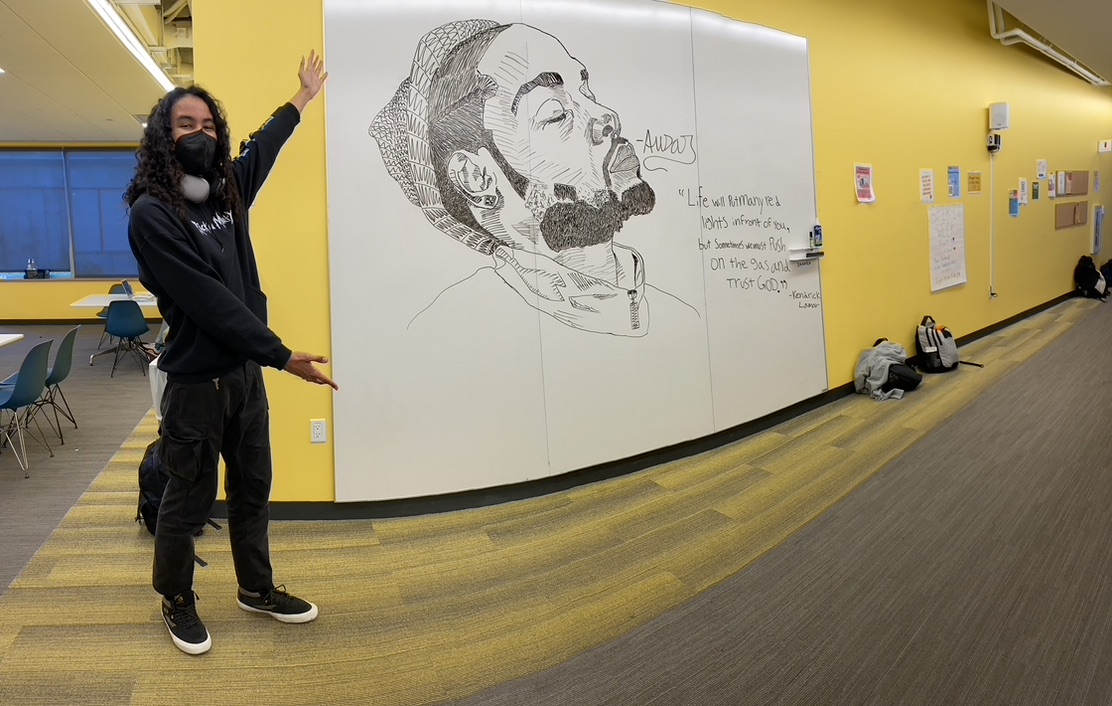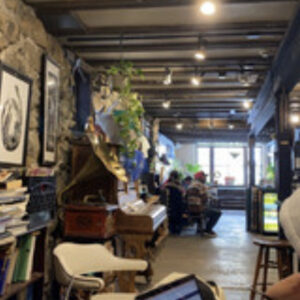
photo by Robin von Breton
Maybe you have seen the detailed drawings on the Center’s whiteboard or a sketch of your favorite music artist in the Second Floor hallway. Or maybe you have even seen a student hard at work with a handful of whiteboard markers. The Lick-Wilmerding High School artist at the whiteboard is Ausar Honable ’24.
Ausar said he began doodling on the white boards just like anyone else. “I just decided to put in my contribution,” he said. Inspired by pop-culture, music and his friends, he draws on the boards weekly.
Ausar said although he has always been into sketching, the medium of dry-erase markers and a whiteboard provides a new sense of creativity. As a kid, he was frustrated by his school’s art programs and their rigidness of style. “The whole point is to be creative and make your own stuff. So when I had someone telling me what to do and how to do it, it wasn’t fun,” said Ausar. He was inspired by his dad’s cartoon-like style growing up.
Ausar said his whiteboard drawings started in middle school. “In fifth grade, they’d give us a little whiteboard to do math on. And I would always make big drawings on them.” When he got to LWHS, the vast whiteboards plastered to almost every wall provided the perfect canvas for developing his style and art.
Going from regular pencil and paper sketching to the short-term, temporary medium of erasable markers on whiteboards has shifted Ausar’s mindset about his art. The ephemerality of the medium “definitely helps with expectations and not getting too disappointed when the drawing doesn’t go to plan,” said Ausar. The provisional component to his art has allowed Ausar to not get so caught up in imperfections. “I would recommend (working in temporary art) to everyone because you definitely have to train yourself to not see (your imperfections) as a negative thing,” said Ausar.
This new form of Ausar’s art falls in line close to the original intention of whiteboards. At LWHS, they were envisioned as a means of communication and interaction within the community. “I think students like to have spaces to use in this way and I love seeing them being used,” said Head of School Eric Temple. “There was no grand master plan for their use, but rather to create organic spaces that could meet the needs of the community whatever those might be at a given time,” he said
Ausar spends the majority of his drawing time at the whiteboard located in the Second Floor Hall. He said the work started out as mostly independent, inspired by his own interests, especially the music he listens to. However, recently, Ausar has enjoyed drawing requests from his friends and passersby. “I like to ask people what their favorite (music) artist is and what they would want to see on the board,” Ausar said. “Since it is a community thing and everyone has to see it, why not draw something that everyone can enjoy?”
Creating in a space where everyone sees his work, whether by choice or not, has influenced Ausar’s mindset around art. While almost every piece of art can knowingly convey and evoke emotion, the art on the whiteboards is digested almost subconsciously. Every person that passes by the whiteboards might not be objectively viewing Honable’s work, but it has the power to influence their day. Ausar sees this as an opportunity for inspiration. He said, “(The fact that) it affects the community makes me want to do almost uplifting (art), it could bring something a little brighter to everyone’s day.”
Ausar’s other whiteboard art project is centered around the Center for Civic Engagement’s Resident Artists internship. The Center’s Resident Artists are a section of the broader Center Internship team. They help get the word out about Center opportunities and events through design and art. It is also a space for the Resident Artists, such as Ausar, to create.
“For example, this year, one opportunity I have provided for them is to think about a social issue they cared about. The Resident Artists chose homelessness, created an art piece around a couple themes of homelessness and created stickers and prints with their designs to sell. Then we donated all the proceeds to a nonprofit,” said Yanni Velasquez, Senior Associate for the Center for Civic Engagement.
After hearing about the opportunity from a friend, Ausar decided to apply. “They’ll (the Center) ask me to put promotional drawings on the whiteboards,” said Ausar, now experienced with creating various promotional drawings for the Center.
When asked about Ausar’s work, Velasquez said, “I really admire that (Ausar’s) type of self drive and not waiting for someone to give you the opportunity to do something. He saw a blank space, he had a vision, and he went for it.”
Ausar said that because both of these projects —the Second Floor Hall whiteboard and the Center— are built into school time, they have provided space for him to make art. When asked about how the shift to more scheduled creative time has changed his perspective on art Ausar said, “I think it’s gotten me to do more art. Because I don’t usually do a lot of drawing or spend a lot of time on it at home.”
The fact that the canvas Ausar works with is located in a busy area has also shifted his mindset on the process of drawing. When he was younger, people viewing his process frustrated Ausar, but since students and staff are constantly walking by as he creates, Ausar has been forced to develop in new ways. “I just wrote off that part of the process as imperfect, or as the parts people should never see, but I now think they really add,” said Ausar.
Watching the process of creation adds intrigue to his audience as well, “I might be drawing something and it’s just a shape or a blob and someone will be like, ‘What’s that?’ I’m like, ‘You’ll see.’ And they’ll come back around and it’s this big, beautiful thing,” Ausar said.
Ausar said his audience influences his art. “It’s just cool to be appreciated. It definitely influences me to want to create more,” said Ausar. He enjoys getting inspiration from others. For example, one of his more recent drawings, of the album, “The Low End Theory” by A Tribe Called Quest, was a recommendation from one of his friends. Ausar said, “It directly inspires me. In the most recent drawing I wrote, ‘What should I do next?’ I want to keep that going, to have everything I do be a recommendation from someone else. I like that people can see their own imagination put forth.”






